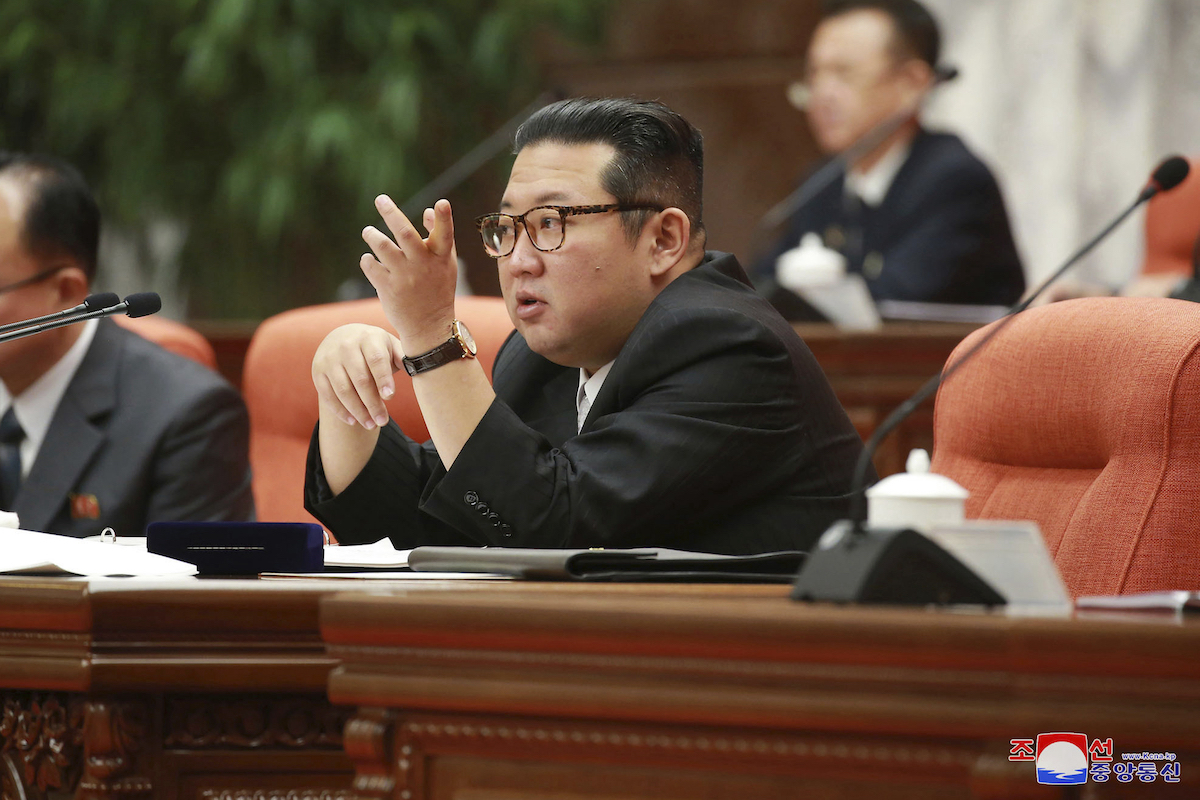Communism has spawned only one full-scale monarchy: the Democratic People’s Republic of Korea. On December 17, 2011, 70-year-old Dear Leader Kim Jong-il died. That very same day, Kim’s 27-year-old son, Kim Jong-un, was put forth as the “Great Successor” and surrounded by elderly “mentors” who were supposed to guide him as he took over the leadership. Many observers counted him out, but he had a killer instinct, literally—ordering the execution of his Uncle Jang Song-thaek, among many others.
Kim then sought to transform his image, moving to reform his economy and open the country up culturally. He even participated in a spate of international summits, most dramatically with President Donald Trump. Yet after the failed Kim-Trump summit in February 2019, the precocious North Korean leader began running almost entirely in reverse. Kim now increasingly looks like a redo of his grandfather’s and father’s authoritarian, isolationist policies, with even more nuclear weapons and missiles in hand.
Throughout his reign, however, he neither hinted at political liberalization nor brooked opposition. Indeed, he ordered a record number of executions—340 within five years, 140 of the executed in the top ranks. And he appeared to make a political point with his choice of means, including antiaircraft guns and a banned nerve agent. The only positive: He was more transparent, acknowledging a failed missile test and poor economic performance, even tearing up during one talk.
And yet, unlike his father, Kim promised real economic change. Kim pere refused to act even amid mass starvation in the 1990s, although he allowed the development of private markets as North Koreans struggled to survive. Then, in 2009, wrote Marcus Noland of the Peterson Institute for International Economics, he employed a mandatory currency exchange “to curtail the rise of market activities and the development of pathways to wealth—and potentially power—beyond state control.”
Kim fils, however, wanted to go another way. Shortly after taking power, he proffered the byungjin policy, or dual economic and military development, to move away from his father’s “military-first” strategy. He promoted autonomy and flexibility for agriculture and industry—limited but meaningful changes. A “new middle class” began to taste more of the good life. In early 2018, explained the University of Virginia’s Ruediger Frank, Kim “went a step further and declared that the goals of byungjin were achieved, and the new strategic line of the Party would be to concentrate all efforts on socialist economic construction.”
A desire to accelerate economic progress apparently animated Kim’s interest in the summits with Trump. The U.S. administration even prepared a curious video purporting to show the kind of economic development that North Korea could expect if Kim yielded his nuclear arsenal.
However, after the failure to reach agreement at the 2019 Hanoi summit, Kim turned inward, largely cutting diplomatic contacts with the U.S. and South Korea, reemphasizing military and nuclear development, sealing the borders in an attempt to keep out COVID-19, and retreating from economic reform. The latter may have been an inevitable result of the North’s decision to isolate itself from the world in response to the pandemic. “North Korea seems to be rolling down the path of new unprecedented levels of isolationism,” noted Daminov Ildar of Visionary Analytics, who believed Pyongyang’s lack of a modern medical system left little choice: “Hermetically sealing itself off from the outside world was the only rational choice.”
Moreover, Kim may have seen greater state control as a necessary response to the failure to achieve sanctions relief. He told leaders of the Workers’ Party of Korea (WPK): “The DPRK-U.S. standoff, which has lasted for generations, has now been compressed into a clear standoff between self-reliance and sanctions.”
At the WPK’s Eighth Congress in January 2021, much was said about the economy, but not much about greater market freedom. Chad O’Carroll, CEO of Korea Risk Group, tweeted that there was “no apparent interest in reform, sanctions relief, or an opening of the economy.” Six months later, The Economist warned that “Entrepreneurial freedoms are being curtailed. State media and party economists have returned to the familiar old rhetoric of autarky and central control.”
Alas, economic retreat has not served the North Korean people well. In April, Kim spoke to the WPK of “another more difficult ‘arduous march,’” as the mass famine in the 1990s was called. A more fundamental change in political direction might also be involved. The agricultural disaster had forced a loosening of economic controls for North Koreans to survive. Victor Cha and Lisa Collins of CSIS contended that “the growth of markets is the single most significant socioeconomic development to occur in North Korea over the last 20 years.” Refugees and defectors crossed the border along with goods. So did information, first on CDs and DVDs, then on flash drives and SD cards.
Kim originally appeared to welcome greater cultural openness. A few months into his tenure, Disney characters took to the stage (without Disney’s approval!) during a televised concert. Kim was reported to have a “grandiose plan to bring about a dramatic turn in the field of literature and arts this year.” In 2018, the DPRK hosted a K-pop concert, which reportedly “moved” Kim.
By now, most North Koreans, including members of the elite, have viewed South Korean movies, television, and K-pop, erasing decades of indoctrination. Observed The New York Times: “North Korean state propaganda had long described South Korea as a living hell crawling with beggars. Through the K-dramas, first smuggled on tapes and CDs, young North Koreans learned that while they struggled to find enough food to eat during a famine, people in the South were going on diets to lose weight.”
Presumably in response, Kim launched an assault on outside culture and campaign for ideological rejuvenation. For instance, he denounced South Korea’s “vicious culture” and his government mandated up to 15 years hard labor for possessing or watching K-pop and other entertainment and death for sellers and smugglers. Anyone found to “speak, write or sing in South Korean style” risks two years imprisonment. Kim even denounced the “attire, hairstyles, speeches, behaviors” of dissolute youth, including North Koreans who adopted more familiar South Korean modes of address.
Earlier this year, a classmate reported “three students cutting their hair like K-pop idols, hemming their pants above their ankles, and singing along to music videos of South Korean songs.” The government sent them to a labor camp for “re-education” and “expelled the students’ parents … for turning a blind eye to their children’s anti-socialist behavior and providing an environment that encouraged the behavior to continue.”
According to a new Transitional Justice Working Group report, there have been executions in “seven instances of ‘watching or distributing South Korean videos.’ … The group notes at least one reported example of a man executed for illegally selling CDs and USBs containing South Korean movies, dramas and music videos.”
Kim has also enlisted DPRK young people in an ideological campaign. As a result of their activism, he said, “vicious sanctions and pressure and tenacious ideological and cultural infiltration has vanished like bubbles in the face of this strong current.” In contrast to the rest of the world, “only the Korean young people who have grown up under the embrace of the socialist motherland unhesitatingly volunteer to exchange their cards of capital citizenship with notes of dispatch to coal mines, cooperative farms, grand construction sites and islands far from cities.”
What happens when COVID ebbs? Some analysts believe that Kim will return to greater economic openness. However, he may have concluded that significant sanctions relief is unlikely without abandoning nuclear weapons. Without greater access to world markets, an open economy offers less growth potential. In addition, the vehemence of his attack on foreign, and especially South Korean, culture suggests he may have come to recognize that his father and grandfather were right to limit economic reform to minimize ideological infection from abroad. Thus, he may seek to maintain economic isolation to promote ideological isolation.
Kim Jong-un took power promising his impoverished, oppressed people a better life. Some observers hoped he would be a reformer. Instead, he has intensified political controls, reversed economic reform, tightened cultural restrictions, and accelerated North Korea’s missile and nuclear programs. Unless he does another volte-face, his people face decades more of stultifying hardship.

